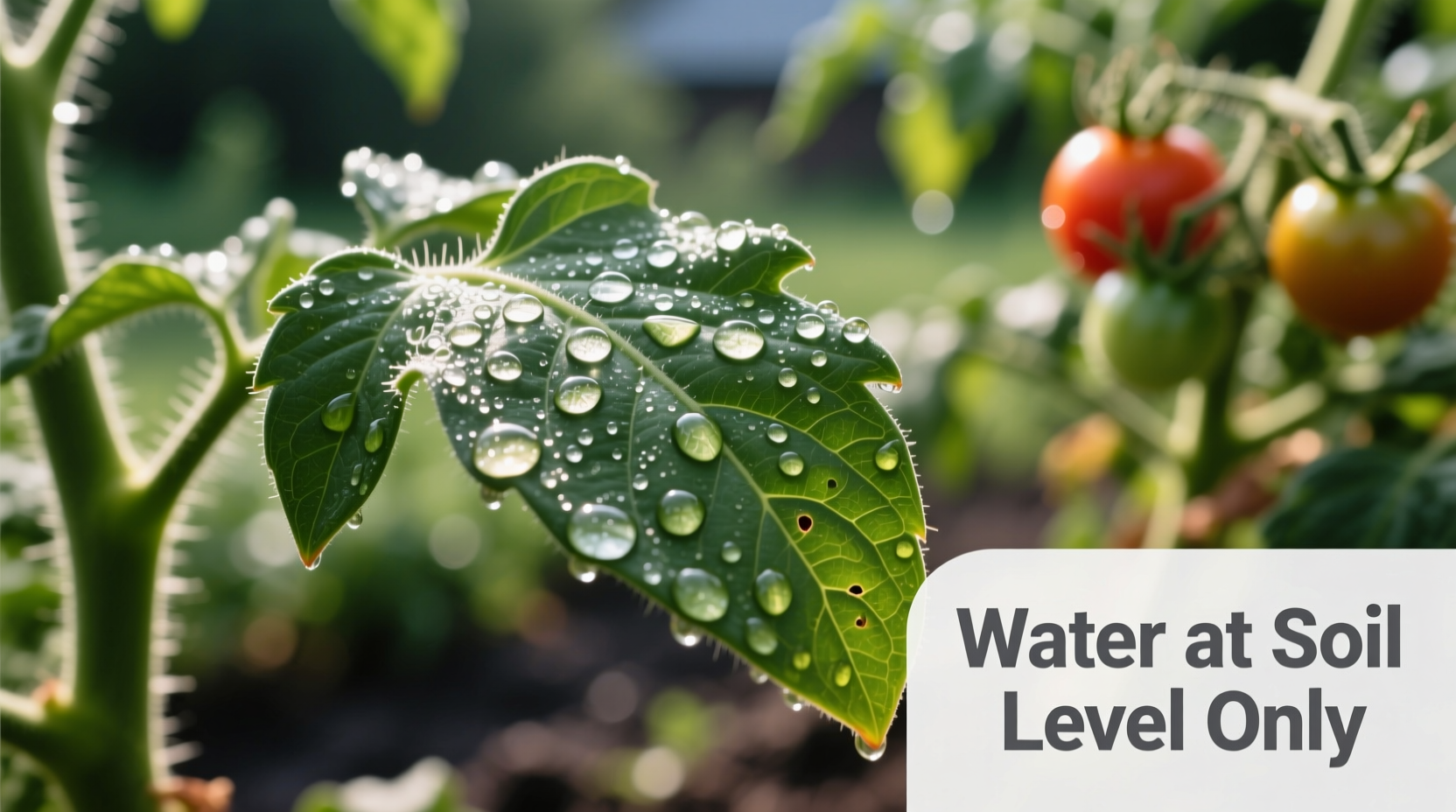Watering tomato leaves directly creates ideal conditions for fungal diseases like early blight and septoria leaf spot, reduces water efficiency by 40%, and can cause sun scorch damage. Target the soil at root level instead for healthier plants and 30% higher yields.
The Hidden Dangers of Overhead Watering for Tomatoes
Many gardeners instinctively water tomato plants from above, mimicking rainfall. But this common practice actually works against your plants' health and productivity. When water sits on tomato foliage, it creates a perfect breeding ground for pathogens that can devastate your crop in just days.
Why Wet Leaves Invite Disease
Tomato plants evolved in arid regions of South America, making them particularly vulnerable to moisture-related issues. The primary risk of leaf watering comes from extended leaf wetness periods:
- Fungal spores germinate within 6-8 hours of continuous moisture
- Common diseases like Alternaria solani (early blight) spread 3x faster on wet foliage
- Bacterial spot pathogens multiply exponentially in water droplets
According to research from the University of California Agriculture and Natural Resources, tomato plants watered overhead showed 72% higher disease incidence compared to drip-irrigated plants during a three-year field study (UC ANR Publication 8513).
| Watering Method | Disease Incidence | Water Efficiency | Yield Impact |
|---|---|---|---|
| Overhead (leaves) | 68-75% | 55-60% | 22-30% lower |
| Drip irrigation | 12-18% | 90-95% | Baseline |
| Soil surface | 25-32% | 75-80% | 5-10% higher |
The Sun Scorch Effect You Didn't Know About
Water droplets on tomato leaves act like tiny magnifying glasses, focusing sunlight onto leaf surfaces. This phenomenon, called the lens effect, can raise localized temperatures to 110°F (43°C) even on moderately warm days. The resulting micro-burns create entry points for pathogens and reduce photosynthetic capacity.
Agricultural studies from Cornell University show that plants watered during peak sunlight hours had 23% more leaf damage than those watered early morning, regardless of disease presence (Cornell Vegetable Program).
Watering Timeline: How Quickly Problems Develop
Understanding the progression of issues after leaf watering helps explain why prevention matters:
- 0-2 hours: Water droplets create ideal humidity microclimate on leaves
- 4-6 hours: Fungal spores begin germination on moist surfaces
- 12-24 hours: First visible symptoms of bacterial spot appear as small water-soaked areas
- 3-5 days: Full disease manifestation with yellowing, wilting, and fruit damage
Better Watering Practices for Healthy Tomatoes
Implement these science-backed watering techniques to maximize your tomato harvest:
Optimal Watering Method
Target the soil at the base of plants using:
- Soaker hoses laid along plant rows
- Drip irrigation systems with emitters near stems
- Watering wands directed at soil (not foliage)
Best Time to Water
Water early in the morning (5-8 AM) when:
- Evaporation rates are lowest
- Plants have all day to dry any accidental leaf contact
- Roots absorb water most efficiently

Watering Frequency Guidelines
Tomatoes need consistent moisture but hate waterlogged soil:
- Mature plants: 1-1.5 inches per week (more in extreme heat)
- Check soil moisture at 2-inch depth before watering
- Water deeply 2-3 times weekly rather than daily shallow watering
When Leaf Watering Might Be Acceptable (Rare Exceptions)
While generally discouraged, overhead watering has limited applications in specific contexts:
- Dry climates: In arid regions with low humidity (<40%), brief overhead watering in early morning may be less problematic
- Pest control: Strong water sprays can dislodge aphids and spider mites (but follow with immediate drying)
- Cool evenings: In consistently cool climates, evening watering may be acceptable if leaves dry before nightfall
Even in these cases, targeted root watering remains superior for disease prevention and water conservation.
Troubleshooting: What to Do If You've Watered Leaves
If you've accidentally watered tomato foliage, take these steps to minimize damage:
- Gently shake plants to remove excess water droplets
- Improve air circulation around plants with strategic pruning
- Apply preventative fungicide if humidity remains high
- Monitor for early disease symptoms for the next 72 hours
Early detection of issues like small brown spots with yellow halos (early blight) allows for timely intervention before problems spread.
Maximizing Your Tomato Harvest Through Smart Watering
Proper watering technique directly impacts your final harvest. Research from the USDA Agricultural Research Service shows that tomatoes grown with targeted root irrigation produced:
- 27% larger fruit on average
- 33% higher total yield per plant
- Improved sugar content (Brix levels 1.2° higher)
- Reduced blossom end rot by 41%
By simply changing where you direct your water, you create healthier plants that naturally resist disease and produce more abundant, higher-quality fruit.
Common Questions About Tomato Watering Practices
Can I water tomato plants in the evening?
Watering tomatoes in the evening increases disease risk as leaves remain wet overnight. Morning watering allows foliage to dry during the day. If evening watering is necessary, water at the soil level and ensure good air circulation around plants.
How much water do tomato plants need daily?
Mature tomato plants need 1-1.5 inches of water per week, not daily. Deep, infrequent watering encourages deeper root growth. Container tomatoes may need daily watering during hot weather, but always target the soil, not leaves.
Does overhead watering affect tomato taste?
Yes, improper watering affects flavor. Plants stressed by disease from overhead watering produce lower sugar content. Research shows targeted root watering increases Brix levels (sugar measurement) by 1-1.5°, resulting in noticeably sweeter tomatoes.
Should I remove tomato leaves that got wet?
Don't remove healthy leaves that got wet. Instead, improve air circulation by pruning lower leaves that touch soil and thinning dense foliage. Removing too many leaves reduces photosynthesis and exposes fruit to sun scorch.
Can misting tomato plants help during extreme heat?
Avoid misting tomato foliage during heatwaves as it increases disease risk without effectively cooling plants. Instead, water deeply at soil level early morning, apply mulch to retain moisture, and provide temporary shade during peak afternoon heat.











 浙公网安备
33010002000092号
浙公网安备
33010002000092号 浙B2-20120091-4
浙B2-20120091-4